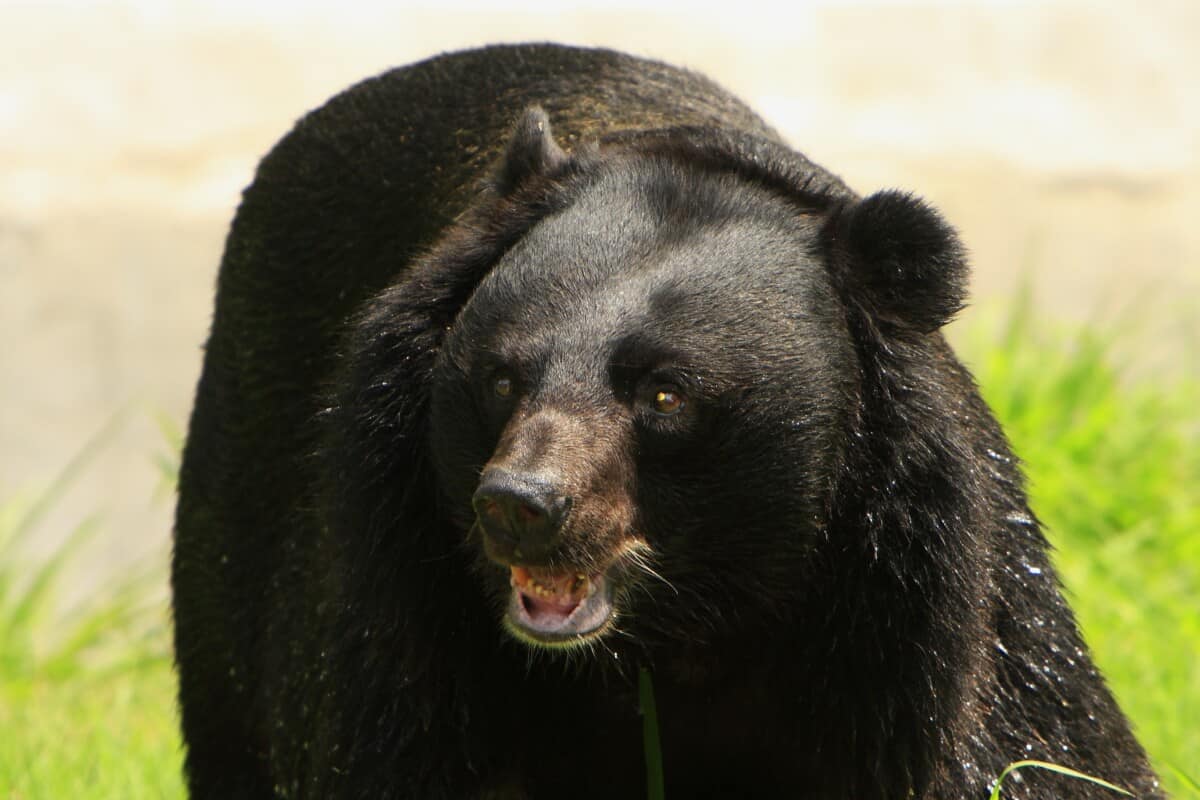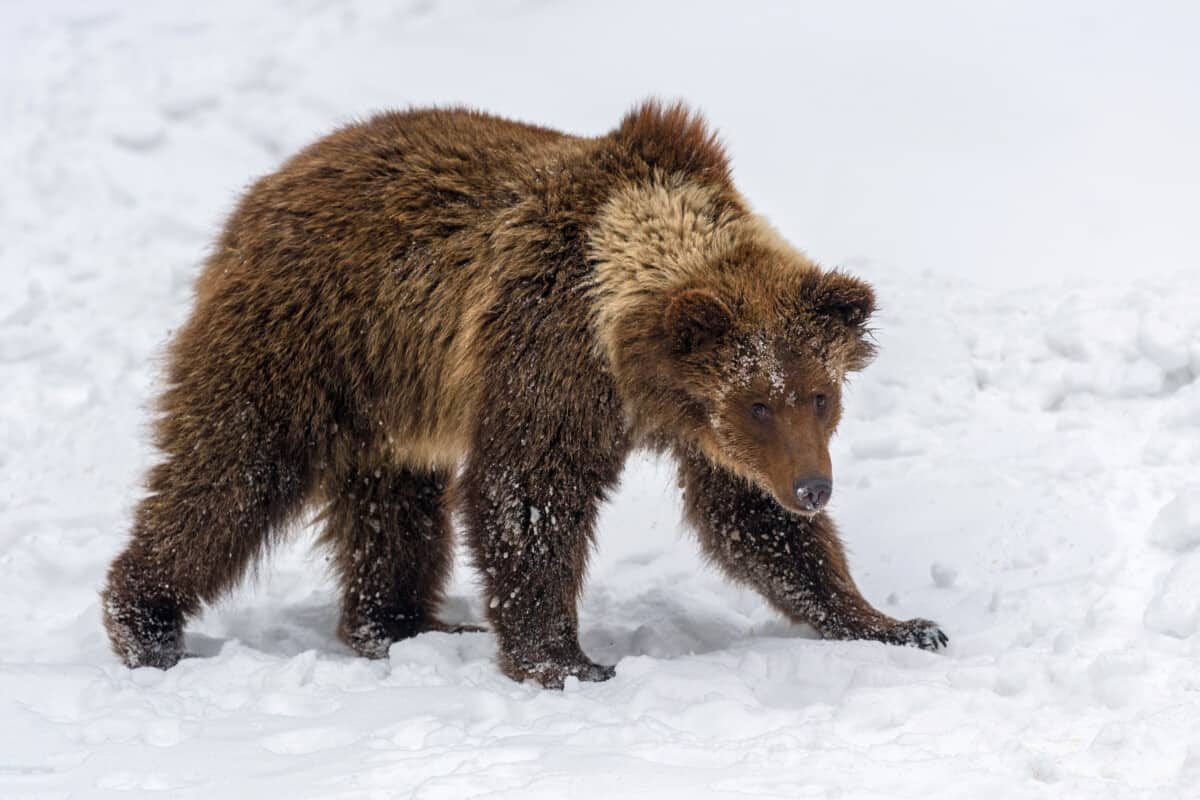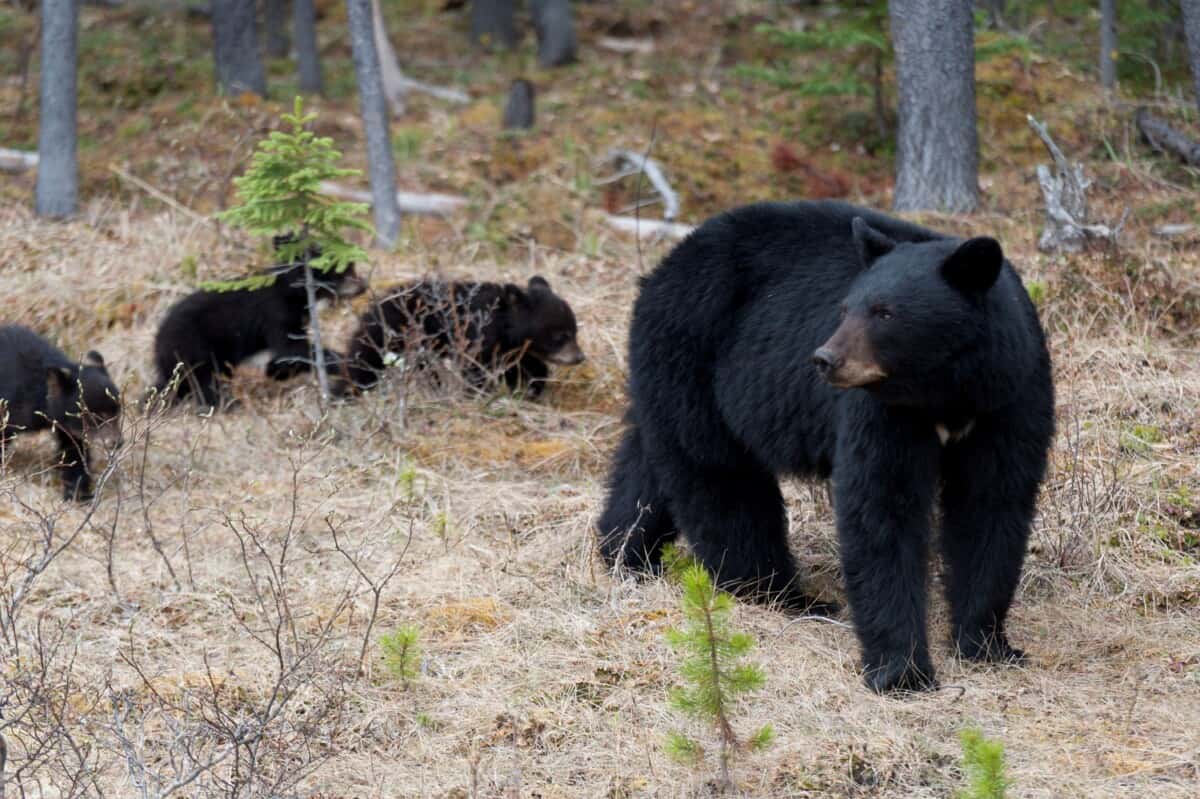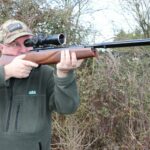I carried my 9mm as a woods gun, but after a record bear was shot near my home, I had to take a second look.
The 9mm can kill bears but is considered underpowered by many. The 9mm has 350 to 450 ft/lbs. of energy, while 1,000 ft/lbs is considered the minimum for a bear hunting gun. Proper 9mm bullets yield sufficient penetration in soft tissue, but it may not stop a bear quickly enough to avoid being mauled.
More important than the cartridge, is the bullet. By far, the most popular ammo for 9mm bear defense is this Buffalo Bore +p load (link to Brownell’s).
I live on the edge of bear country and have carried a 9mm in the woods. There are some reasons why, and a lot of reasons why not. So, sit by my campfire and let’s talk guns.

Table of Contents
Will 9mm Kill a Bear?
In 2017, a story went viral in outdoor magazines and youtube channels. Phill Shoemaker published a story about fending off a 450 pound she-grizzly that charged at his fishing clients in Alaska. In seconds, he fired and landed 6 shots from a compact 9mm into the beast’s side, and once more into its butt as it ran off and stumbled down.
Apart from being an exciting and thriling story that belongs in a hunting book, it’s not really a good thing that happened. Yes, he killed the bear, and yes no one was harmed, but his pistol was excruciatingly near not stopping that bear. After 7 hits, the bear turned and ran. 7 shots didn’t stop it from moving any direction it wanted to go. He only had one bullet left.
That’s the part that should scare you the most. Put yourself in that situation, except one or two shots didn’t hit their mark. You shoot once more, realizing your gun is empty, and the bear is still out there, wounded and angry. Not a good spot to be in, particularly in the middle of the Alaskan wilderness.
I’ve painted a harsh picture on purpose. I want you to realize that when you are out in God’s country, it’s you versus nature, and nature fights hard to win. The wilderness doesn’t care about you, your gun, or your training. We all are small when it’s just us pitted against the nature of the wild.
If you want to instantly kill a bear, you have to shoot into either the brain or brain stem. That’s very hard to do because the head is the smallest and least still target on an animal. Most lethal gunshots kill from bleeding out, and that takes a few minutes. But, pain and weakness from loss of blood can convince a bear to quit fighting. That’s the point at which a bear turns around and runs off.
I’ve carried a 9mm on my waist in the woods quite a lot and seldom have I felt it’s not adequate. Is that a foolish mindset from an overconfident man? Perhaps. Before we can make that determination, let’s talk ballistics and hard numbers.
The 9mm is considered a mid-power handgun cartridge. The standard weight of a 9mm bullet is 124 grains. It generally fires with a velocity of 1.250 fps, muzzle energy of 350 ft/lbs., and has a ballistic coefficient of around 0.15, which means it has a lot of drag. The mean diameter of a 9mm bullet is .355 in.
The average North American bear is 350 pounds of tough, thick-skinned grit and has a true will to survive. They can run up to 35 miles per hour and can have a bite force of 1,000 psi. That’s strong enough to crack a bowling ball. Now you know what you’re up against.

Is 9mm Really Enough for Bear?
I’ve found four instances of when a 9mm pistol was used to stop a dangerous bear. Three of the four times, it worked. I don’t want to be that fourth guy. Kinda makes me rethink carrying my 9mm in the woods. I did say the 9mm for bears does have some pros, and I’ll get to those.
By all metrics, the 9mm isn’t adequate as a bear gun. Still, it’s becoming increasingly more common to see a 9mm carried in bear country because most shooters can accurately and quickly fire rounds from the mild cartridge, which is essential in a tense situation. It used to be said that a 44 caliber black powder army revolver was adequate to kill bears. Most of those revolvers weren’t far off from our modern 9mm.
Let me introduce another old cartridge, the 32/20. The 32/20 also hails from the black powder days of large smoke clouds and slow bullets. It was a common rifle used on deer and bear across the country by our grandfather’s grandfathers.
It fired a 100-grain bullet at 1,000 feet per second, with 325 ft/lbs of energy, and a .312 in. bullet. That sounds a lot like a 9mm. Actually, modern 9mm loads are all more powerful than that. Was it a good choice? No, it wasn’t, not by today’s standards. But it was acceptable to many in the late 1800s who needed a cheap gun and cheap ammo.
So my question to you is, are you willing to compromise this much on function and power in order to use a 9mm pistol? 9mm pistols can be cheap and may work, but bears are always dangerous. the old-timers who used low-power 32/20’s put themselves in dangerous positions.
Bear defense is when an angry bear decides you’d look better dead. It’s very close up, and usually without warning. You may not have any margin for error. I know spending money can be tight, but a bear’s jaws will be tighter. If you can only afford one pistol, consider a caliber that will do everything, like the 10mm AUTO.

Will the 9mm Penetrate Enough to Kill a Bear?
Standard 115 or 124-grain fmj bullets will penetrate to around 18 inches in thick-skinned soft tissue. That’s enough penetration if you have a good shot angle. If you have to take a shot on a bad angle, it may take 18 inches to even reach vital organs in the first place. But, they don’t tend to make a big wound.
Deeper penetrating bullets, like Buffalo Bore Heavy Outdoorsman or Underwood Extreme Penetrator can penetrate soft tissue over 3 feet deep from a 9mm pistol. These bullets go deeper mainly because they are more stable and don’t tumble as a standard round-nosed fmj does. They are designed to go straight and make a better wound.
Once again, if you want to drop a bear dead, you have to shoot the brain or brain stem. most shots, even when hunting, kill by blood loss. So, if a major artery is severed by a bullet, unconciousness will occur anywhere from 10 to 30 seconds. Death will follow shortly.
The three main targets are the upper chest, neck, and head. if you’re thinking a headshot is an easy kill, let me tell ya. I put four rounds of 40 S&W in the head of a 400-pound pig. The first two were at a bad angle and too far back. They went through the neck muscle and into the dirt below. The next shot went through the neck, into the jaw, and the fourth finally hit the 2-inch brain. Ever tried to corral a wild pig? I’d advise against it.
The point is, brains are hard to hit. If that’s the shot I get, darn sure I’m going to take it! Honestly, I’d take a shot I’d get and you should too. The biggest part of any defensive shooting is to find a target and get bullets in it fast. Think fast and shoot faster.
By the way, have you ever done speed drills? Have you ever practiced drawing from the holster and getting multiple shots on target in seconds? It’s a good drill for any defensive application.

Have people Killed Grizzly bears With a 9mm?
There have been at least three Grizzlies killed in recent years with a 9mm pistol during a defensive situation. In all of them but one at leat four shot were required. The outlier here was a police officer who shot a bear out of a tree, striking it’s brain on the first hit.
Yes, it has happened. In recent years, there was a story in Anchorage about a young man who killed a large grizzly with an AK74, firing a 21 caliber bullet. Somehow it worked. I won’t ever recommend you attempt a repeat of that expirament.
The thing about guns is that everything is a compromise. The whole idea of a 9mm pistol is to have a non-cumbersome, lightweight gun with relatively cheap ammo. The issue with that is it means hard to aim and low power. That’s the compromise with 9mm handguns.
If you are asking this question, I’ll wager you own a 9mm pistol and don’t really want to pony up the cash for a new gun right now. The smaller and less powerful the gun, the more of a danger you are potentially putting yourself in. What’s that compromise worth to you?

When is a 9mm a Good Choice for Bears?
Answer: When it’s what you have. My compact 9mm isn’t a true bear gun, but it beats a sharp stick.
I carried a 9mm at times because it’s all I had ammo for. That’s an honest reason to carry one. Another good reason is if your 9mm is the only pistol you can shoot well. That’s another part as to why I carried a 9mm in bear country. I could always shoot that Remington significantly better than my Glock. If you can’t hit anything, the gun isn’t going to do you any good.
With the increase in popularity of concealed carry, a lot of people are going into the woods with a compact 9mm carry pistol on thier waist. That’s not actually that bad, because most of them would have never carried a pistol before, so it’s a start.
Technically speaking, the 9mm out penetrates both 40 S&W and 45 acp, so it’s got some merit among the mid-sized handgun rounds, but not a lot.
I Am Carrying a 9mm for Bears, What’s the Best Ammo?
Buffalo Bore +p Heavy outdoorsmen is the most popular option by far for bear protection in a 9mm handgun. Black Hills Ammo is offering their new Honey Badger in 9mm, which penetrates equal to a 115-grain fmj, but with a much wider wound channel.
My personal favorite is Lehigh Defense Extreme Penetrators. They’ll penetrate a good two to three feet, and make decent damage for a 9mm bullet. this is the same bullet Underwood Ammo is loading in their Extreme Penetrator ammo. It is impressive, to say the least.
What Would be a Good Bear Gun?
The Most popular Bear Handgun is a 44 magnum revolver. They are powerful, and will probably do the job well. in fact, in the 12 documented cases I could find of bear defense with a 44 magnum, none of them failed.
If you are interested in getting a dedicated bear gun, good for you! You want one powerful enough to get the job done under less ideal conditions. The minimum handgun caliber for bear defense is the 10mm AUTO. It fires a .40 in. bullet, between 180 and 220 grains. The heavier bullets are on par with a 45 but are faster and more powerful.
Full power 10mm loads will have between 650 ft/lbs. and 750 ft/lbs of energy out of most pistols. But, most of the fmj ammo is loaded at or near 40S&W specifications. A full power 180 grain 10mm will have a stated velocity of at least 1350 fps. Some are even hotter. Not bad for a semi-auto pistol!
My favorite 10mm bear load is either Buffalo Bore Heavy outdoorsman 220 grain or the Extreme Penetrators. Both are top scorers for 10mm bear loads. If you have big hands, look at the Glock 20 pistol in 10mm. If you have smaller hands, you can check out some of the skinnier 1911’s in 10mm.
The 500 S&W has been gaining more traction in the last 10 years as a bear gun. It’s the most powerful pistol you can buy. It isn’t painful to fire unless you already have wrist trouble. They are expensive, but will certainly boost your confidence.
The .357 Magnum fires a bulet very close to the 9mm but way faster. You shoud use the heaviest bullet you can get, preferebly 180 grain going around 1200 fps. While it’s slower than the 10mm 180 grain, it will penetrate equal because it’s a skinnier bullet with less drag.
You can also consider long guns. I know men who carry a 12 gauge shotgun with magnum slugs as a backup bear gun on Alaskan hunts. I also know a man who carries an AR chambered in 450 Bushmaster. It’s a compact gun with twice the power of a 44 magnum. There are many great options. Unfortunately, the 9mm isn’t one of them.















































